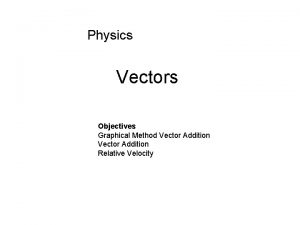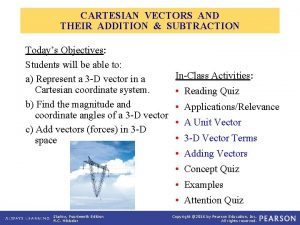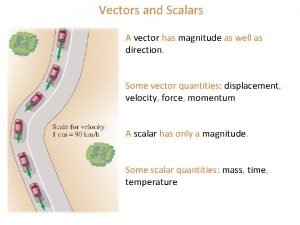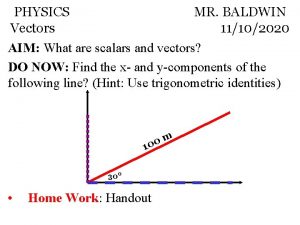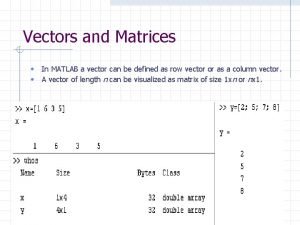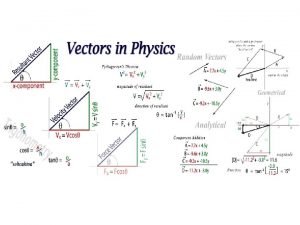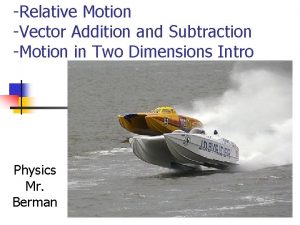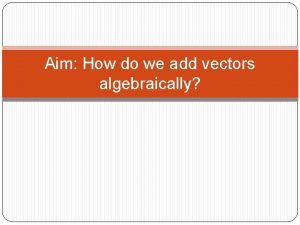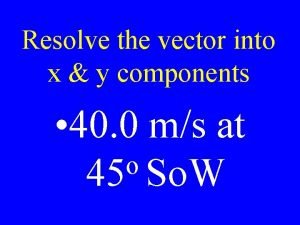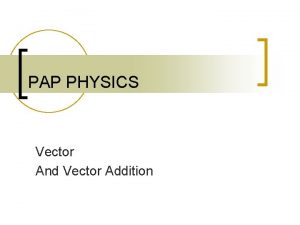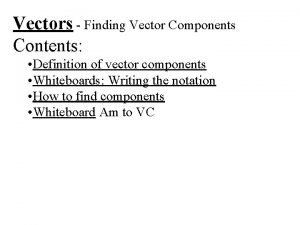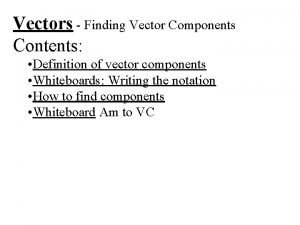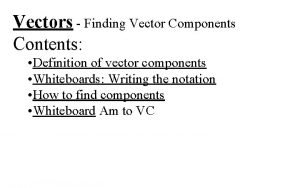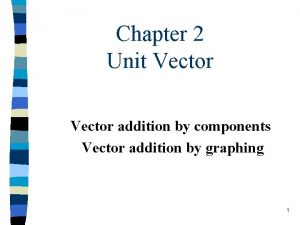Vector Addition How to resolve vectors into components














- Slides: 14

Vector Addition How to resolve vectors into components and algebraically add them using a spreadsheet.

Vector Addition Perpendicular Vectors: A resultant (R) can be gotten by placing two vectors (V 1 and V 2) head to tail and solving for the resultant using Pythagorean Theorem. Y R X V 1 Qxr V 2 The direction is an angle counterclockwise from the positve X axis: Qxr

Equations Pythagorean Theorem: Inverse Tangent IF V 2 is negative (q. XR is in quadrant 2 or 3), add 180 to reverse the direction.

What about when vectors are not perpendicular to each other? Y X A B Vectors should still be placed head to tail and a resultant drawn from the tail of the first to the head of the last.

Adding Non-Perpendicular Vectors Y A X Resultant B Although graphically this technique works it is difficult to apply the math necessary to determine a resultant, particularly if there are more than two vectors that must be added.

Vector Decomposition • Therefore we will use the method of vector decomposition to add vectors. – This is an approach that uses the components of the vectors to perform vector addition rather than the vectors themselves. Vector components of a vector V are the two vectors parallel to the X and Y coordinate axes whose resultant is equal to the original vector V.

How do we calculate components? For a given vector V at angle qxr Y X V Vy qx Vx Vy = Y component of V Vx = X component of V qx = angle measured counterclockwise from the + X axis.

Adding Non-Perpendicular Vectors Y VXA X A VYA B VXB Now after determining the components of A and B. VYB

Adding Non-Perpendicular Vectors Y VXA X VYA VYB VXB And replacing the original vectors with them.

Adding Non-Perpendicular Vectors Y X Resultant VYA VYB VXB The components are summed head to tail. VXA

Combining the individual vectors to get the components of the Resultant: RX and RY VXB + VXA = RX VYB + VYA = RY RY R = Resultant RX

Equations Pythagorean Theorem: Inverse Tangent IF RX is negative (q. XR is in quadrant 2 or 3), add 180 to reverse the direction.

You will now use a spreadsheet to…. • Calculate the components of any vector given its magnitude and direction • Calculate the magnitude of the resultant of any number of vectors • Calculate the final direction of the resultant given the sum of the components of each vector.

Tips • An IF function is used to calculate the direction of the resultant. – A cell containing an IF function can have two possible values. – It uses a logical test to check a given value using a greater than or less than comparison. • IF the test is true the result of the function is calculated using the “value if true” part of the function • IF the test is false the result of the function is calculated using the “value if false” part of the function
 How to resolve vectors
How to resolve vectors Why is vector resolution the opposite of vector addition
Why is vector resolution the opposite of vector addition Graphical method of vector addition
Graphical method of vector addition Addition and subtraction
Addition and subtraction Graphical addition of vectors
Graphical addition of vectors Tip to tail method
Tip to tail method Magnitude formula
Magnitude formula Vector addition formula
Vector addition formula Matlab vector of vectors
Matlab vector of vectors Matlab
Matlab Magnitude of a vector
Magnitude of a vector Formula for partitioning a line segment
Formula for partitioning a line segment Vector addition
Vector addition Define relative velocity
Define relative velocity How to add two vectors algebraically
How to add two vectors algebraically


